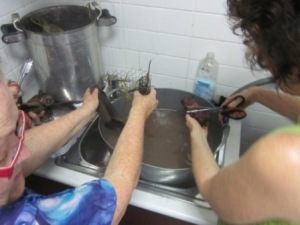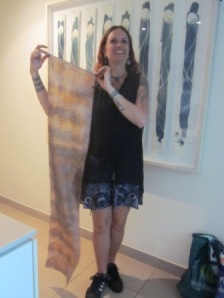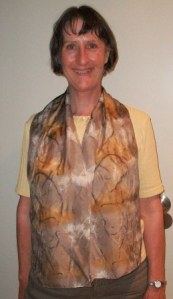When I lived here in 1999-2000 I used to visit my friend Nancy every couple of weeks and we played with white cotton and Procion dyes on her lanai. We scrunched, we mixed, we salted, we dropped wet and dry dye on top of our pieces to see what would happen. It was wonderful, and I still have some of those pieces which sneak their way into my quilts once in a while.
We are back in Darwin for 5 days, and today I had the chance to do another workshop – with artist Aly de Groot in her home. For two hours and a bit we played with silk scarves, rusty metal, eucalyptus leaves and tea. What resulted was the colours of Australia, believe it or not!
First, Ali sent us out into the street to find eucalyptus leaves. We picked a whole bunch off the trees (you can also use dry), and came back and put most of them in a large pot full of boiling water. I love it that we were using natural (and free!) dyes for this process. There were no safety considerations, because we were just using leaves. Then she showed us what we were going to do.
We each had a plain white silk scarf to work with. Ali had all kinds of rusty things – wire, chicken wire, spring bits – which we could use in any way. There was lots of black loose leaf tea which we could sprinkle anywhere we wanted. We also had some more leaves to place, even some purple onion skins. There’s no wrong way to do this – just have fun!
The eucalyptus leaves will add brown/taupe to the piece. The black tea leaves turn orange, and the rusty metal make the fabric turn black. The Colours of Australia!
It all gets rolled up really tightly. On the outside to keep the roll in place you can either curl some rusty wire around it or tie some string (we used plastic string). If you tie it tightly enough, the string will act as a resist and you’ll get some white bits. It took no time at all to do this.
Then it gets tossed into the dye vat. The eucalyptus leaves have at this point been boiling for about a half an hour, drawing out the colour from the eucalyptus oil.
- Ali did a second roll using rusty chicken wire and tea and ti tree leaves.
We then had a cuppa (tea or coffee) and after the whole thing boiled for a half an hour, we fished our rolls out of the pot.
We unwrapped and rinsed in water with a bit of fabric softener in it. Then we ironed the pieces immediately with a hot iron. OMG – how beautiful were these pieces! Here’s Ali’s piece:
And here’s what the rest of us did!
Ali’s dog, Princess Peanut, even got in on things. Clearly, she knows her way around a dye studio.
I’m impressed at how quickly this process happened – it’s much faster than using Procion dyes and cotton. We didn’t prepare our silk in any way. We opened the package and added our stuff on top. Because we kept the scarves folded in half, they are all symmetrical. Ali assures us the dyes are permanent. We could have left the rolled-up scarves in the dye bath for a lot longer (days and days), which would have resulted in much deeper colours.
I have a eucalyptus tree in my back yard at home, but there are many more things you can use. Ali uses the most fragrant leaves, not necessarily the most colourful. It’s a chemical reaction to the oils of the leaves, and more fragrant oils create more vivid colours. I’m going to try using some of my pine needles when I get home. Maybe some sagebrush from the interior of BC, too, and see what colours it creates. You can use cotton or any natural fibre instead of silk (but of course, silk takes dyes really really well).
I don’t wear scarves. Never have. But I just might have to wear this one – I love it, and I made it myself in Darwin!
Thanks for the great workshop, Aly!









December 21, 2013 at 8:40 pm |
I love the colours you got!
December 21, 2013 at 10:30 pm |
Me too, Vireya!
December 21, 2013 at 9:15 pm |
Love it Cathy. No way I can grow a gum tree here in Edmonton. I wonder if eucalyptus oil would work. I have the silk scarves, the tea, some rusty metal but being a fan of the gum tree would love to use it.
December 21, 2013 at 10:30 pm |
I’ve no idea, Sandra – try it out! There had to be quite a few leaves in the dye bath with water – we had many handfuls of them. Or use some pine or spruce leaves instead.
December 22, 2013 at 1:09 am |
great workshop – thanks for sharing, Cathy. Love your scarf too.
December 22, 2013 at 4:30 am |
Thanks, Fran!
December 27, 2013 at 2:04 am |
How great does this scarf look. And yes, colours of Australia. I used to do exactly that sort of dyeing when I used to spin yarn. I think I still have all the bits and pieces (cups and pots) tucked away somewhere. Inspiring. And Happy New Year btw, to you and John.
December 29, 2013 at 3:08 am |
HNY to you and Neecie, too, Jan! I loved making this scarf so much, I might have to go into production!